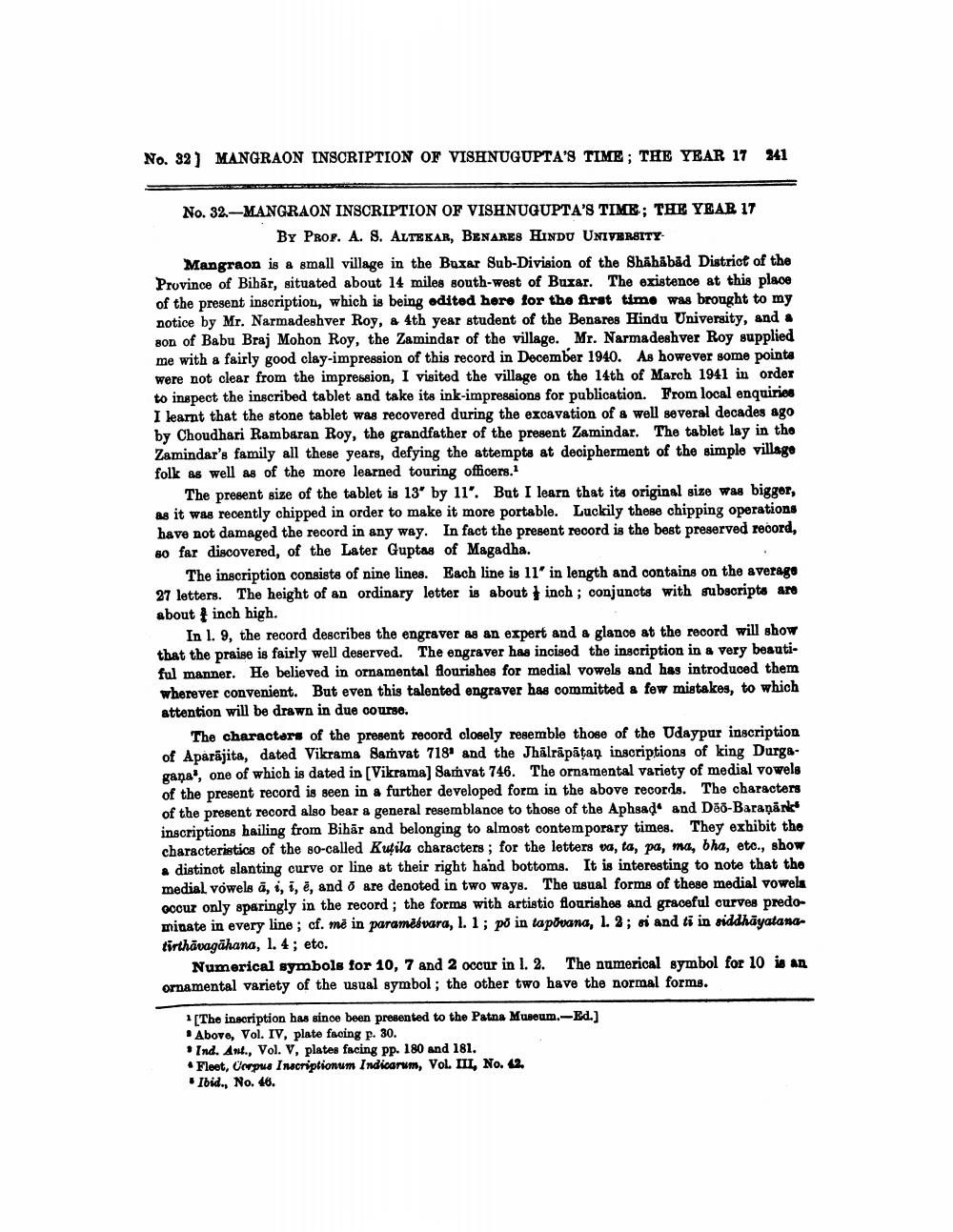________________
No. 32 ] MANGRAON INSCRIPTION OF VISHNUGUPTA'S TIME; THE YEAR 17
241
No. 32-MANGRAON INSCRIPTION OF VISHNUGUPTA'S TIME; THE YEAR 17
BY PROF. A. 8. ALTEKAR, BENARES HINDU UNIVERSITY Mangraon is a small village in the Buxar Sub-Division of the Shahābād District of the Province of Bihar, situated about 14 miles south-west of Buxar. The existence at this place of the present inscription, which is being edited here for the first time was brought to my notice by Mr. Narmadeshver Roy, & 4th year student of the Benares Hindu University, and . son of Babu Braj Mohon Roy, the Zamindar of the village. Mr. Narmadeshver Roy supplied me with a fairly good clay-impression of this record in December 1940. As however some pointa were not clear from the impression, I visited the village on the 14th of March 1941 in order to inspect the inscribed tablet and take its ink-impressions for publication. From local enquiries I learnt that the stone tablet was recovered during the excavation of a well several decades ago by Choudhari Rambaran Roy, the grandfather of the present Zamindar. The tablet lay in the Zamindar's family all these years, defying the attempts at decipherment of the simple village folk as well as of the more learned touring officers.
The present size of the tablet is 13" by 11". But I learn that its original size was bigger, as it was recently chipped in order to make it more portable. Luckily these chipping operations have not damaged the record in any way. In fact the present record is the best preserved record, 80 far discovered, of the Later Guptas of Magadha.
The inscription consists of nine lines. Each line is ll' in length and contains on the averago 27 letters. The height of an ordinary letter is about inch; conjuncts with subscripts are about # inch high.
In l. 9, the record describes the engraver as an expert and a glance at the record will show that the praise is fairly well deserved. The engraver has incised the inscription in a very beautiful manner. He believed in ornamental flourishes for medial vowels and has introduced them wherever convenient. But even this talented engraver has committed a few mistakes, to which attention will be drawn in due courso.
The characters of the present record closely resemble those of the Udaypur inscription of Aparajita, dated Vikrama Samvat 7189 and the Jhālrāpātan inscriptions of king Durgagana', one of which is dated in (Vikrama) Samvat 746. The ornamental variety of medial vowels of the present record is seen in a further developed form in the above records. The characters of the present record also bear a general resemblance to those of the Aphsado and Dão-Baranánk inscriptions hailing from Bihär and belonging to almost contemporary times. They exhibit the characteristics of the so-called Kutila characters; for the letters va, ta, pa, ma, bha, etc., show . distinot slanting curve or line at their right hand bottoms. It is interesting to note that the medial. vowels a, i, i, e, and 8 are denoted in two ways. The usual forms of these medial vowela occur only sparingly in the record; the forms with artistio flourishes and graceful curves predominate in every line; cf. më in parameswara, 1.1; po in tapovana, 1. 2; vi and ti in siddhayatana tirthāvagāhana, 1.4; etc.
Numerical symbols for 10, 7 and 2 occur in l. 2. The numerical symbol for 10 is an ornamental variety of the usual symbol; the other two have the normal forms.
1[The inscription has since been presented to the Patna Museum.-Ed.) • Above, Vol. IV, plate facing p. 30. • Ind. Ant., Vol. V, plates facing pp. 180 and 181. • Fleet, Corpus Inscriptionum Indicarum, VOL IIL, No. 12.
Ibid., No. 46.




